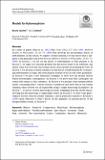Files in this item
Models for hylomorphism
Item metadata
| dc.contributor.author | Jacinto, Bruno Miguel | |
| dc.contributor.author | Cotnoir, Aaron | |
| dc.date.accessioned | 2019-03-19T13:30:13Z | |
| dc.date.available | 2019-03-19T13:30:13Z | |
| dc.date.issued | 2019-03-11 | |
| dc.identifier | 256901635 | |
| dc.identifier | 81728d14-a03a-40ed-832e-c1a9380c5199 | |
| dc.identifier | 85062872855 | |
| dc.identifier | 000494222600007 | |
| dc.identifier.citation | Jacinto , B M & Cotnoir , A 2019 , ' Models for hylomorphism ' , Journal of Philosophical Logic , vol. In press . https://doi.org/10.1007/s10992-019-09501-3 | en |
| dc.identifier.issn | 0022-3611 | |
| dc.identifier.other | ORCID: /0000-0003-4528-7570/work/65702583 | |
| dc.identifier.uri | https://hdl.handle.net/10023/17312 | |
| dc.description | The research and writing of this paper was supported in part by a 2017–2018 Leverhulme Research Fellowship from the Leverhulme Trust. | en |
| dc.description.abstract | In a series of papers (Fine et al., 1982; Fine, Noûs28(2), 137–158; 1994, Midwest Studies in Philosophy, 23, 61–74, 1999) Fine develops his hylomorphic theory of embodiments. In this article, we supply a formal semantics for this theory that is adequate to the principles laid down for it in (Midwest Studies in Philosophy, 23, 61–74, 1999). In Section 1, we lay out the theory of embodiments as Fine presents it. In Section 2, we argue on Cantorian grounds that the theory needs to be stabilized, and sketch some ways forward, discussing various choice points in modeling the view. In Section 3, we develop a formal semantics for the theory of embodiments by constructing embodiments in stages and restricting the domain of the second-order quantifiers. In Section 4 we give a few illustrative examples to show how the models deliver Finean hylomorphic consequences. In Section 5, we prove that Fine’s principles are sound with respect to this semantics. In Section 6 we present some inexpressibility results concerning Fine’s various notions of parthood and show that in our formal semantics these notions are all expressible using a single mereological primitive. In Section 7, we prove several mereological results stemming from the model theory, showing that the mereology is surprisingly robust. In Section 8, we draw some philosophical lessons from the formal semantics, and in particular respond to Koslicki’s (2008) main objection to Fine’s theory. In the appendix we present proofs of the inexpressibility results of Section 6. | |
| dc.format.extent | 661381 | |
| dc.language.iso | eng | |
| dc.relation.ispartof | Journal of Philosophical Logic | en |
| dc.subject | Objects | en |
| dc.subject | Parthood | en |
| dc.subject | Composition | en |
| dc.subject | Mereology | en |
| dc.subject | Hylomorphism | en |
| dc.subject | Rigid embodiment | en |
| dc.subject | Variable embodiment | en |
| dc.subject | Qua-objects | en |
| dc.subject | Atomism | en |
| dc.subject | Gunk | en |
| dc.subject | Junk | en |
| dc.subject | Aristotle | en |
| dc.subject | Neo-Aristotelian | en |
| dc.subject | Cantor | en |
| dc.subject | Cardinality | en |
| dc.subject | Iterative | en |
| dc.subject | Hierarchy | en |
| dc.subject | B Philosophy. Psychology. Religion | en |
| dc.subject | T-NDAS | en |
| dc.subject.lcc | B | en |
| dc.title | Models for hylomorphism | en |
| dc.type | Journal article | en |
| dc.contributor.sponsor | The Leverhulme Trust | en |
| dc.contributor.institution | University of St Andrews. Philosophy | en |
| dc.identifier.doi | 10.1007/s10992-019-09501-3 | |
| dc.description.status | Peer reviewed | en |
| dc.identifier.grantnumber | RF-2017-046\10 | en |
This item appears in the following Collection(s)
Items in the St Andrews Research Repository are protected by copyright, with all rights reserved, unless otherwise indicated.

